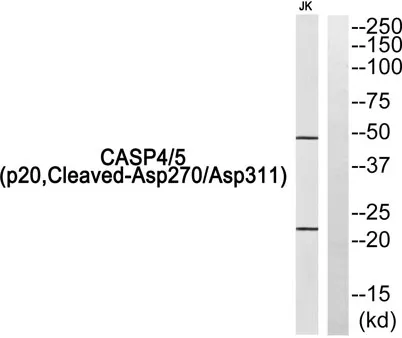Cleaved-Caspase-4/5 p20 (D270/D311) rabbit pAb
CAT:
855-ES7702-02
Size:
100 μL
Price:
Ask
- Availability: 24/48H Stock Items & 2 to 6 Weeks non Stock Items.
- Dry Ice Shipment: No




Cleaved-Caspase-4/5 p20 (D270/D311) rabbit pAb
- Description: This gene encodes a protein that is a member of the cysteine-aspartic acid protease (caspase) family. Sequential activation of caspases plays a central role in the execution-phase of cell apoptosis. Caspases exist as inactive proenzymes composed of a prodomain and a large and small protease subunit. Activation of caspases requires proteolytic processing at conserved internal aspartic residues to generate a heterodimeric enzyme consisting of the large and small subunits. This caspase is able to cleave and activate its own precursor protein, as well as caspase 1 precursor. When overexpressed, this gene induces cell apoptosis. Alternative splicing results in transcript variants encoding distinct isoforms. [provided by RefSeq, Jul 2008],
- Synonyms: CASP4; ICH2; Caspase-4; CASP-4; ICE(rel)-II; Protease ICH-2; Protease TX; CASP5; ICH3; Caspase-5; CASP-5; ICE(rel)-III; Protease ICH-3; Protease TY
- Gene ID: 837
- UniProt: P49662/P51878
- Cellular Locus: Cytoplasm, cytosol. Endoplasmic reticulum membrane ; Peripheral membrane protein ; Cytoplasmic side. Mitochondrion. Inflammasome. Secreted. Predominantly localizes to the endoplasmic reticulum (ER). Association with the ER membrane requires TMEM214 (PubMed:15123740). Released in the extracellular milieu by keratinocytes following UVB irradiation (PubMed:22246630)..
- Host: Rabbit
- Species Reactivity: Human
- Immunogen: The antiserum was produced against synthesized peptide derived from human Caspase 4/5. AA range:221-270
- Clonality: Polyclonal
- Validated Applications: WB, ELISA
- Stability: 1 year
- Concentration: 1 mg/mL
- Dilution: Western Blot: 1/500 - 1/2000. ELISA: 1/40000. Not yet tested in other applications.
- Molecular Weight: 47,22kD
- Storage Conditions: PBS with 0.02% sodium azide and 50% glycerol pH 7.4. Store at -20°C. Avoid repeated freeze-thaw cycles.
